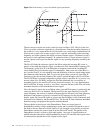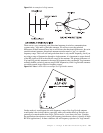
104 Handbook of Intercom Systems Engineering
Figure 7.12
Good linearity is a must for faithful signal reproduction.
The next receiver section we look at is the first local oscillator (LO). The job of the first
LO is to provide a reference signal that is a fixed distance from the operating frequency of
the system. It is very important the first LO be stable over a wide range of temperatures. In
fixed crystal systems, one or more crystals cut to a specific relationship of the operating
frequency are used to generate this highly accurate reference signal. A different crystal is
necessary for each operating frequency. In synthesized units, a single reference crystal is
used in a phase-lock-loop to provide the signal for any operating frequency needed by the
receiver.
The First LO feeds the reference signal to the Mixer where the incoming RF carrier is
mixed, or beat with the reference signal, to produce the First Intermediate Frequency (IF).
The frequency of the First IF is the difference in frequency between the incoming RF
carrier and the First LO reference signal. Unfortunately, what comes out of the Mixer is
not a just the First IF, it is the algebraic sum and difference of the two signals being mixed
plus numerous other harmonic junk. To get to the point where you have a clean First IF
consisting of just the desired frequency, the signal is passed through to the First IF Filter.
The First IF Filter is extremely important to proper receiver operation. It is a passive, very
narrow (often 50 to 250 KHz), and precise filter that eliminates the vast majority of
unwanted signals so the true First IF can be processed correctly. It is very important that
the First IF Filter be sharp, as well as, very linear. Any non-linearity in the filter will cause
unwanted distortion of the demodulated source signal.
Next, the signal is sent to the second Mixer where a second IF frequency is produced in the
same way the First IF was obtained. The Second LO is the same frequency for any RF
carrier frequency the receiver is capable of because the first LO takes care of the frequency
differences and produces an always-constant First IF frequency for the Second IF to
handle. Again, the Second IF signal as it leaves the Second Mixer is full of harmonic junk
and needs to be filtered by the Second IF Filter. The Second IF filter eliminates unwanted
harmonic energy and prepares the signal to be demodulated.
The next phase of the receiver is the Demodulator. There are several types of
demodulators used by wireless manufacturers today and it would be beyond the scope of
this book to discuss them all in detail. Suffice to say, through a type specific process the
Demodulator extracts the source signal from the Second IF carrier. The quality of the
Demodulator circuit is critical to good audio quality. Any type of signal distortion or
modification that takes place in the demodulation process will cause the final signal to be a
less than perfect reproduction of the original source signal.
DISTORTED COPY
N
o
n
i
L
L
i
n
e
n
a
r
N
L
i
n
e
a
r
S
e
c
t
io
n
o
n
e
a
r
GOOD COPY
N
o
n
i
L
L
i
n
e
n
a
r
N
L
i
n
e
a
r
S
e
c
t
io
n
o
n
e
a
r


















